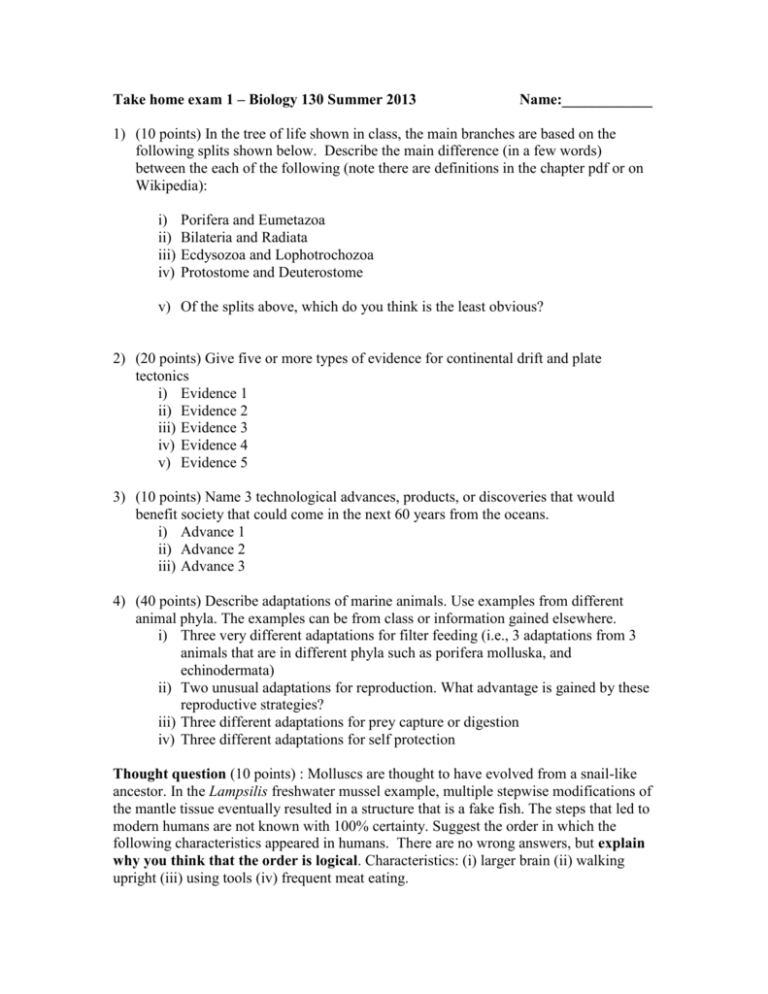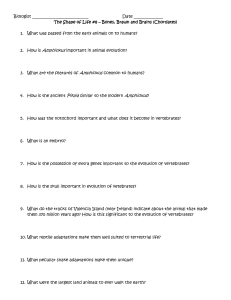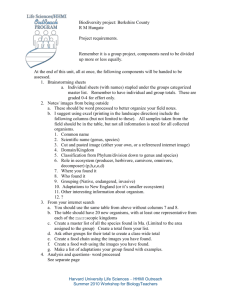Take home exam 2 – Biology 130 Summer 2013
advertisement

Take home exam 1 – Biology 130 Summer 2013 Name:____________ 1) (10 points) In the tree of life shown in class, the main branches are based on the following splits shown below. Describe the main difference (in a few words) between the each of the following (note there are definitions in the chapter pdf or on Wikipedia): i) ii) iii) iv) Porifera and Eumetazoa Bilateria and Radiata Ecdysozoa and Lophotrochozoa Protostome and Deuterostome v) Of the splits above, which do you think is the least obvious? 2) (20 points) Give five or more types of evidence for continental drift and plate tectonics i) Evidence 1 ii) Evidence 2 iii) Evidence 3 iv) Evidence 4 v) Evidence 5 3) (10 points) Name 3 technological advances, products, or discoveries that would benefit society that could come in the next 60 years from the oceans. i) Advance 1 ii) Advance 2 iii) Advance 3 4) (40 points) Describe adaptations of marine animals. Use examples from different animal phyla. The examples can be from class or information gained elsewhere. i) Three very different adaptations for filter feeding (i.e., 3 adaptations from 3 animals that are in different phyla such as porifera molluska, and echinodermata) ii) Two unusual adaptations for reproduction. What advantage is gained by these reproductive strategies? iii) Three different adaptations for prey capture or digestion iv) Three different adaptations for self protection Thought question (10 points) : Molluscs are thought to have evolved from a snail-like ancestor. In the Lampsilis freshwater mussel example, multiple stepwise modifications of the mantle tissue eventually resulted in a structure that is a fake fish. The steps that led to modern humans are not known with 100% certainty. Suggest the order in which the following characteristics appeared in humans. There are no wrong answers, but explain why you think that the order is logical. Characteristics: (i) larger brain (ii) walking upright (iii) using tools (iv) frequent meat eating. Thought question (10 points) We are examining the diversity of animal types to better understand what an animal is. Whether science provides a useful way to understand ourselves and humans in general is a matter of opinion. Consider the following scenario and decide what you would do. You are hiking in the remote wilderness with your dog Retch. You are enjoying the solitude when suddenly a wall of water from a flash flood comes hurtling through the canyon. Retch is swept into the raging torrent. As an extremely fit, former Navy SEAL, you rush down the canyon to save Retch when you see that there is another hiker, a complete stranger, who is also about to drown, and there is a 1000 foot waterfall just downstream. You only have time to save Retch or the stranger. No one else is around to help. What do you do? Justify your answer. Is there a scientific basis for your answer? Note – since you are very strong, there is no danger of the stranger pulling you into the water. The stranger does not have any distinguishing features but does not look like he has a lot of money or is smoking hot like Justin Bieber. Retch is also not rich or smoking hot. On a side note, you had told Retch to stay in camp, but instead he followed you, so you could argue that you are not responsible for him being in harm’s way.





